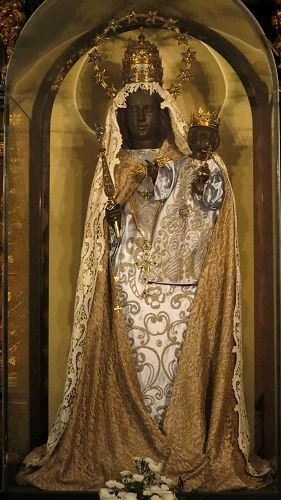Cologne
Photo: Ella Rozett
The Black Mother of God (die schwarze Muttergottes)
St. Mary in the Kupfergasse
Mother of Mercy
Schwalbengasse 1, on the corner of Neven-DuMont-Strasse and Kupfergasse, downtown Cologne, before 1675, life size, natural wood.
Not long before the year 1675 the mayor of Cologne made a vow to go on pilgrimage to the Holy House and the Black Madonna of Loreto (see Italy). When he realized that he wasn't going to be able to fulfill his promise, he made a deal with the Mother of God: Instead of going to Loreto, he was to build a copy of the Loreto chapel in Cologne. To this end he went to negotiate with the abbess of the Carmelite convent in the city, to see if she would sell him a certain little part of the convent's property. The abbess wasn't surprised but happy. For more than ten years there had been signs that Heaven wanted just such a chapel in just that place. Many times after evening prayers the nuns had heard mysterious, lovely voices sing the Loreto litany in the place the mayor wanted for his chapel. Before her death, the previous abbess had prophesied that a grace filled chapel of the Mother of God would be built there.¹
The people of Cologne say that their chapel was built after plans sent from Loreto, but the two look totally different to me. Perhaps the ground-plan is identical.
The statue, which is made of dark linden wood, was probably imported by the Carmelites from their motherhouse in Holland. The chapel was finished and consecrated in 1675. During eight days of celebration, masses of faithful surrounded the chapel. Soon the news spread that, as would be expected of a true Black Madonna, the Black Mother of God in the Kupfergasse answered prayers. Ever since, she has been known as an 'image of grace,' (Gnadenbild). Catholic as well as Protestant pilgrims have come to her from as far away as Holland. - When people are in need, they don't care what denomination their saving angel is.
It is a Catholic custom to place an Eternal Lamp near the tabernacle which holds consecrated hosts, i.e. the true presence of Christ. Similarly Eternal Lamps are installed before many 'images of grace' of the Mother of God. They honor her true presence in these images. The Black Mother of God of Cologne received a precious Eternal Lamp early on, but it was lost when French revolutionary troops occupied Cologne.
In 1925, Pope Pius XI gave her a Papal 'tiara', i.e. a three tiered crown of Popes.² I guess it’s lonely at the top and he wanted to share his reign with the Mother of God. (Good idea!) It took about another four decades before Popes completely stopped wearing crowns.
The present (in 2007) parish priest, Father Klaus-Peter Vosen, published a lovely little brochure in which he explains the legends surrounding his Black Mother of God. Two stories, probably both made up, seek to explain why she is black. One says that there was a fire in the chapel. It darkened Our Lady, but could not destroy her. To the priest this means she wears her darkness as a sign of her victory, like Christ bears the signs of his wounds on his resurrected body.
The other story says that when the plague, the Black Death, had broken out in Cologne the people took refuge in Saint Mary of the Kupfergasse, entrusting their fate to her intersession. The next day the disease disappeared but Our Lady had turned black. Again like Christ, she had taken upon herself her children's sin and punishment.
Like many, Vosen links the Black Mother of God to the bride of the Song of Songs, who to Jews and Christians, is the bride of God. As she darkened because of her work in her brothers' vineyard, so Mother Mary allows herself to be 'burnt' as it were, by serving in the vineyard of her son - the community of the redeemed.³ Ever since she asked Jesus to provide more wine at the wedding feast in Kana "Mary continues to do the same faithful service: She intercedes for all those who - for whatever reason - ran out of the wine of joy of life. (…) Still today, Mary "burns" herself, full of fervent love, in the service of God, which is inseparable from service to people."⁴
Footnotes:
1. See the parish website: www.kupfergasse.de
2. Klaus-Peter Vosen, Das Antlitz der Mutter:Gnadenbilder Mariens im Erzbistum Köln, J.P. Bachem Verlag, Köln: 2007, p. 30
3. Klaus-Peter Vosen, Warum ist die Mutter Gottes Schwarz?, Mutabene Verlag, 2006, p. 4-5 + 11
4. Ibid, p. 13


